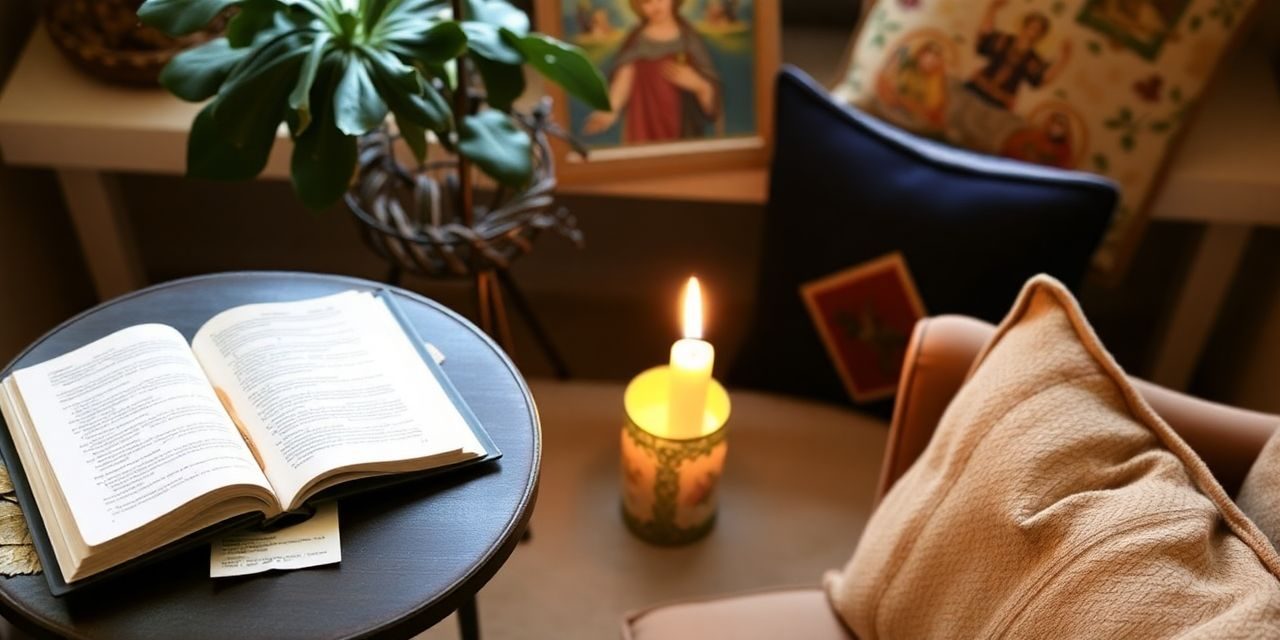The Importance of a Dedicated Prayer Space
When I first carved out a small corner of my home for prayer and meditation, I had no idea how profoundly it would impact my spiritual life. Having a dedicated space for connecting with the divine changes your home into a personal sanctuary.
It’s a physical reminder of your commitment to spiritual growth and a haven where you can retreat from the chaos of daily life.
Creating a sacred space isn’t about following rigid rules or spending a fortune on decorations. It’s about crafting an environment that resonates with your soul and supports your spiritual practice.
Whether you have an entire room or just a tiny nook, the key is to infuse the space with intention and meaning.
Choosing the Right Location
The first step in creating your sacred space is finding the perfect spot. This doesn’t necessarily mean dedicating an entire room, a corner of your bedroom, a quiet area in your living room, or even a small space in your garden can work beautifully.
When I was selecting my prayer space, I found myself drawn to a small alcove near my bedroom window. The natural light and view of the sky made it feel expansive and connected to nature.
Consider factors like privacy, comfort, and the energy of the space.
You want an area where you can pray or meditate without interruptions.
Here are some factors to consider when choosing your location:
- Natural light: If possible, choose a spot with access to natural light.
Sunlight can help create a warm, inviting atmosphere and connect you with the natural world.
- Quietness: Select an area away from high-traffic zones in your home.
The less external noise and distraction, the better.
- Size: While bigger isn’t always better, confirm you have enough space to sit comfortably and include any items you want in your sacred space.
- Energy: Pay attention to how you feel in different areas of your home.
Some spots might naturally feel more peaceful or inspiring than others.
- Accessibility: Choose a location that’s easy to access daily.
If it’s too out of the way, you might be less inclined to use it regularly.
The perfect spot might not be obvious at first. Spend some time in different areas of your home, close your eyes, and see where you feel most at peace.
Clearing and Cleansing the Space
Once you’ve chosen your location, it’s time to prepare the space energetically. This process involves more than just tidying up, this involves setting intentions and creating a clean slate for your spiritual practice.
Start by decluttering the area. Remove any items that don’t serve your spiritual purpose.
This might mean clearing out old magazines, moving furniture, or taking down distracting artwork.
As you remove each item, visualize clearing away any stagnant energy along with it.
Next, give the space a thorough cleaning. As you clean, focus on your intention to create a sacred space.
You might even want to use natural cleaning products with calming scents like lavender or sage to enhance the purifying process.
Many spiritual traditions have specific cleansing rituals. Here are a few you might consider:
- Smudging: Burning sage or palo santo is a common practice for clearing negative energy.
Light the herb, let it smolder, and walk around your space, allowing the smoke to fill every corner.
- Sound cleansing: Use bells, singing bowls, or even clapping to break up stagnant energy.
The vibrations can help clear the space and set a peaceful tone.
- Salt cleansing: Sprinkle sea salt in the corners of your space and leave it overnight before vacuuming it up.
Salt is believed to absorb negative energy.
- Essential oils: Diffuse purifying essential oils like lemon, tea tree, or eucalyptus to cleanse the air and create a fresh atmosphere.
- Visualization: Close your eyes and visualize a bright, white light filling the space, pushing out any darkness or negativity.
Choose a method that aligns with your beliefs and feels right to you. The most important aspect is your intention to create a clean, positive environment for your spiritual practice.
Designing Your Sacred Space
Now comes the exciting part: designing your sacred space. This is where you can let your creativity shine and create an environment that truly speaks to your soul.
There’s no one-size-fits-all approach.
Your sacred space should be a reflection of your unique spiritual path.
Start with the basics: comfortable seating is essential. This could be a meditation cushion, a prayer bench, or simply a soft rug.
The goal is to create a space where you can sit comfortably for extended periods without physical discomfort distracting you from your practice.
Next, consider adding elements that inspire and support your practice. Here are some ideas:
- Altar: An altar can serve as a focal point for your sacred space.
It doesn’t have to be elaborate, a small table or shelf will do.
Place meaningful objects, religious symbols, or inspirational items on your altar.
- Nature elements: Bringing a bit of nature into your space can help you feel grounded and connected. This could be as simple as a small potted plant, a bowl of river stones, or a vase of fresh flowers.
- Lighting: Soft, warm lighting can create a peaceful atmosphere.
Consider using candles, salt lamps, or soft LED lights.
If you have natural light, you might want to use sheer curtains to soften it.
- Color: Choose colors that make you feel calm and inspired. This might mean painting a wall, adding colorful cushions, or hanging artwork in specific hues.
- Textiles: Soft, comfortable textiles can make your space more inviting.
Consider adding a cozy blanket, a soft rug, or cushions in textures that appeal to you.
- Scent: Aromatherapy can enhance your spiritual practice.
Use an essential oil diffuser, incense, or scented candles with calming fragrances like lavender, sandalwood, or frankincense.
- Sound: If you enjoy music or nature sounds during your practice, set up a small speaker or sound machine.
Alternatively, you might include instruments like singing bowls or chimes.
- Personal touches: Include items that have personal significance to you.
This could be family heirlooms, souvenirs from meaningful trips, or gifts from loved ones.
When I was creating my space, I found that incorporating elements from nature really helped me feel grounded and connected. I added a small potted plant, a bowl of river stones, and a Himalayan salt lamp. The warm glow and natural textures immediately made the space feel more sacred.
Less is often more when it comes to sacred spaces. You don’t want the area to feel cluttered or overwhelming.
Each item should serve a purpose and contribute to the overall peaceful atmosphere.
Incorporating Meaningful Objects
Your sacred space is the perfect place to keep objects that hold special meaning for you. These might be religious icons, family heirlooms, or items you’ve collected on your spiritual path.
Each object should serve a purpose, whether it’s to inspire, comfort, or help with your practice.
Here are some ideas for meaningful objects you might include:
- Sacred texts: Keep your favorite spiritual or inspirational books nearby.
This could be religious texts, poetry collections, or books on meditation and mindfulness.
- Prayer beads or rosary: These can be useful tools for focused prayer or meditation.
- Journal: A special notebook for recording your thoughts, prayers, or spiritual insights can be a valuable addition to your space.
- Crystals or gemstones: If you resonate with crystal energy, incorporate stones that have meaning for you.
- Photos: Images of loved ones, spiritual teachers, or inspiring figures can remind you of your connections and aspirations.
- Artwork: Choose pieces that evoke feelings of peace, inspiration, or connection to the divine.
- Symbolic objects: Items that represent important aspects of your faith or spiritual path, such as a cross, Buddha statue, or mandala.
- Natural objects: Feathers, shells, or special stones you’ve collected can serve as reminders of your connection to nature.
- Candles: Beyond providing light, candles can symbolize enlightenment, purification, or the divine presence.
- Water feature: A small fountain or bowl of water can represent purification and the flow of life.
When selecting objects for your sacred space, quality is more important than quantity. Each item should have significance and contribute to the overall energy of your space.
Take time to consider why you’re including each object and what it means to you.
I found that creating a small altar in my sacred space helped me focus my intentions. On it, I placed a candle to represent divine light, a small statue that had been passed down through my family, and a smooth river stone I’d picked up on a meaningful hike.
Each time I sit in my space, these objects remind me of my spiritual goals and connections.
Creating Ambiance with Light and Sound
The atmosphere of your sacred space plays a crucial role in supporting your prayer and meditation practice. Lighting and sound are two powerful tools for creating the right ambiance.
Lighting
Natural light is ideal if possible. If your space has a window, consider using sheer curtains to soften the light and create a gentle, diffused glow.
For artificial lighting, soft, warm lights are generally more conducive to a peaceful atmosphere than harsh overhead lights.
Candles can add both light and a sense of ceremony to your practice. The flickering flame can serve as a focal point for meditation and symbolize the presence of the divine.
If you’re concerned about fire safety, flameless LED candles can provide a similar effect.
Consider incorporating different levels of lighting in your space. A combination of overhead lighting, table lamps, and candles allows you to adjust the atmosphere to suit different moods or types of practice.
Sound
Sound can be equally important in creating a sacred atmosphere. This might mean ensuring quiet by using a white noise machine or earplugs if you live in a noisy area.
Alternatively, you might incorporate sound into your practice with meditation music, chimes, or singing bowls.
Here are some ways to use sound in your sacred space:
- Background music: Soft, instrumental music or nature sounds can help create a peaceful atmosphere.
- Chimes or bells: These can be used to mark the beginning and end of your practice or to bring your attention back when your mind wanders.
- Singing bowls: The resonant tones of singing bowls can help induce a meditative state.
- Mantras or chants: If your spiritual practice involves vocal elements, make sure your space supports this.
- Water features: The gentle sound of flowing water can be incredibly soothing.
In my own space, I found that a small tabletop fountain provided the perfect background sound. The gentle trickle of water helps me feel calm and centered as soon as I enter the space.
The goal is to create an environment that helps you disconnect from the outside world and connect with your inner self. Experiment with different combinations of light and sound until you find what works best for you.
Maintaining Your Sacred Space
Creating your sacred space is just the beginning. To truly benefit from this special area, it’s important to maintain it both physically and energetically.
Physical Maintenance
Regularly dust and clean your space, taking care to handle sacred objects with respect. This physical cleaning can be a spiritual practice in itself, a way of honoring your commitment to your spiritual growth.
Here are some tips for physical maintenance:
- Regular cleaning: Dust, vacuum, and wipe surfaces regularly.
This keeps your space fresh and shows respect for the sacred items in your space.
- Refresh natural elements: If you have plants or fresh flowers in your space, make sure to water them and replace them when necessary.
- Check candles and lighting: Replace burnt-out bulbs and trim candle wicks to confirm they burn cleanly.
- Organize regularly: Keep your space tidy and organized. This helps maintain a sense of peace and order.
Energetic Maintenance
Energetically, you might choose to periodically re-cleanse the space using the methods you used when you first created it. This can be especially helpful if you’ve been through a difficult time or if the energy in your home feels stagnant.
Here are some ways to maintain the energy of your space:
- Regular smudging or energy clearing: Use sage, palo santo, or other methods to clear the energy of your space periodically.
- Set intentions: Regularly reaffirm your intentions for the space.
This helps maintain its purpose and energy.
- Refresh your altar: If you have an altar, consider changing it with the seasons or as your focus shifts.
- Energy cleansing visualizations: Regularly visualize white light or healing energy filling your space.
Most importantly, use your space regularly. The more you pray, meditate, or simply sit quietly in your sacred space, the more powerful it will become.
It’s like creating a groove in the universe, a special place where you can more easily connect with the divine.
Adapting Your Space Over Time
As you grow and evolve on your spiritual path, don’t be afraid to let your sacred space evolve too. What worked for you when you first created the space might change over time.
Be open to rearranging, adding new elements, or even relocating your space if it feels right.
Here are some ways your space might evolve:
- Changing focus: As your spiritual practice develops, you might want to adjust your space to reflect new interests or practices.
- Seasonal changes: Consider making small changes to your space to align with the changing seasons or important dates in your spiritual calendar.
- Life changes: Major life events might prompt you to refresh or redesign your space to reflect your new circumstances.
- Deepening practice: As your practice deepens, you might find you need different tools or a different layout to support longer meditation sessions or new types of prayer.
Your sacred space is a living reflection of your inner world. By creating and maintaining this special area in your home, you’re making a powerful statement about the importance of your spiritual life.
You’re carving out a little piece of heaven right here on earth, a sanctuary where you can connect, reflect, and grow.
The most important element in your sacred space is you. Your presence, your intention, and your practice are what truly make the space sacred. So create your space with love, use it with devotion, and watch as it becomes a powerful tool in your spiritual journey.
Frequently Asked Questions
How big should a prayer room be?
A prayer room can be any size that comfortably accommodates your needs. It could be as small as a corner in your bedroom or as large as a dedicated room. The key is having enough space to sit or kneel comfortably and include any items important to your practice.
What should I put in my prayer room?
Common items for a prayer room include comfortable seating, religious texts, candles, prayer beads, and meaningful spiritual objects. Include items that support your specific spiritual practice and help you feel connected to the divine.
How do I create a meditation space in a small room?
To create a meditation space in a small room, focus on essentials like a comfortable cushion or chair, soft lighting, and minimal decor. Use vertical space with wall-mounted shelves for storage.
A folding screen can create a dedicated area that can be tucked away when not in use.
What color is good for a prayer room?
Colors that promote calm and focus are often best for prayer rooms. Soft blues, greens, and neutrals are popular choices.
However, the best color is one that resonates with you personally and aligns with your spiritual beliefs.
How do I purify my prayer room?
Common methods to purify a prayer room include smudging with sage or palo santo, using sound cleansing with bells or singing bowls, diffusing essential oils, or simply opening windows to let in fresh air. The method you choose should align with your personal beliefs and practices.
Can I have a prayer room in my bedroom?
Yes, you can absolutely have a prayer room or sacred space in your bedroom. Many people find this convenient, especially if space is limited. Just confirm you can create a sense of separation between your sleep area and your prayer space.
How often should I clean my sacred space?
Regular cleaning of your sacred space is important. A quick daily tidy and a more thorough weekly cleaning can help maintain the energy of the space.
Some people also choose to do a deeper energetic cleansing monthly or seasonally.
What is the significance of an altar in a sacred space?
An altar serves as a focal point in a sacred space. It’s a place to display meaningful objects, make offerings, and focus your intentions.
The altar represents a bridge between the physical and spiritual worlds in many traditions.
How can I make my prayer space more inviting?
To make your prayer space more inviting, confirm it’s clean and clutter-free, use soft lighting, incorporate comfortable seating, add elements of nature like plants or stones, and include personal touches that are meaningful to you.
Can I use electronic devices in my sacred space?
While many prefer to keep their sacred space free from electronics, some find value in using devices for guided meditations, spiritual music, or reading sacred texts. If you choose to include electronics, be mindful of potential distractions.
Key Takeaways:
- Choose a quiet, comfortable location for your sacred space
- Cleanse the area both physically and energetically
- Incorporate meaningful objects and natural elements
- Create a calming ambiance with suitable lighting and sound
- Maintain your space regularly, both physically and spiritually
- Allow your sacred space to evolve as you grow on your spiritual journey





